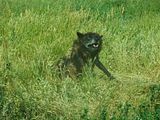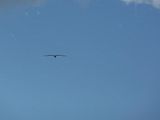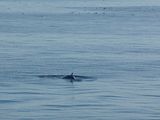http://en.wikipedia.org/wiki/Kopi_LuwakCultivars, blends, and tastes
Luwak Coffee BeansKopi luwak is a name for many specific cultivars and blends of arabica, robusta, liberica, excelsa or other beans eaten by civets, hence the taste can vary greatly. Nonetheless, kopi luwak coffees have a shared aroma profile and flavor characteristics, along with their lack of bitterness.
Kopi luwak tastes unlike heavy roasted coffees, since roasting levels range only from cinnamon color to medium, with little or no caramelization of sugars within the beans as happens with heavy roasting. Moreover, kopi luwaks which have very smooth profiles are most often given a lighter roast. Iced kopi luwak brews may bring out some flavors not found in other coffees.
Sumatra is the world's largest regional producer of kopi luwak. Sumatran civet coffee beans are mostly an early arabica variety cultivated in the Indonesian archipelago since the seventeenth century. The major Sumatran kopi luwak production area is in Lampung, Bengkulu and Aceh especially the Gayo region, Takengon. Tagalog cafe alamid (or alamid cafe) comes from civets fed on a mixture of coffee beans and is sold in the Batangas region along with gift shops near airports in the Philippines.
[edit] Kopi muncakKopi muncak (or kopi muntjak), a different type of coffee produced in a similar process, is made from the dung of barking deer (muntjac) found throughout Southeast Asia. Unlike civet coffee, Kopi muncak is mostly gathered in the wild, chiefly in Indonesian Archipelago.[citation needed]
[edit] Production
An Asian Palm CivetKopi is the Indonesian word for coffee. Luwak is a local name of the Asian palm civet in Sumatra. Palm civets are primarily frugivorous, feeding on berries and pulpy fruits such as from fig trees and palms. Civets also eat small vertebrates, insects, ripe fruits and seeds.[3]
Early production began when beans were gathered in the wild from where a civet would defecate as a means to mark its territory. On farms, civets are either caged or allowed to roam within defined boundaries.[1]
Coffee cherries are eaten by a civet for their fruit pulp. After spending about a day and a half in the civet's digestive tract the beans are then defecated in clumps, having kept their shape and still covered with some of the fleshy berry's inner layers. They are gathered, thoroughly washed, sun dried and given only a light roast so as to keep the many intertwined flavors and lack of bitterness yielded inside the civet.
[edit] Research
Defecated luwak coffee berries, East JavaSeveral studies have examined the process in which the animal's stomach acids and enzymes digest the beans' covering and ferment the beans.[4][5][6] Research by food scientist Massimo Marcone at the University of Guelph in Ontario, Canada showed that the civet's endogenous digestive secretions seep into the beans. These secretions carry proteolytic enzymes which break down the beans' proteins, yielding shorter peptides and more free amino acids. Since the flavor of coffee owes much to its proteins, there is a hypothesis that this shift in the numbers and kinds of proteins in beans after being swallowed by civets brings forth their unique flavor. The proteins are also involved in non-enzymatic Maillard browning reactions brought about later by roasting. Moreover, while inside a civet the beans begin to germinate by malting which also lowers their bitterness.[7][8]
At the outset of his research Marcone doubted the safety of kopi luwak. However, he found that after the thorough washing, levels of harmful organisms were insignificant. Roasting at high temperature has been cited as making the beans safer after washing.[by whom?][citation needed]
[edit] Civet coffee imitationResearch into the palm civet's digestive processes and the transformation of the beans' proteins has led to the discovery of innovative ways to imitate the taste of kopi luwak without the civet's involvement. It is a response to the decrease in civet population, caused by hunting for meat.[9][improper synthesis?] Kopi luwak production involves a great deal of labor, whether farmed or wild-gathered. The small production quantity and the labor involved in production contribute to the coffee's high cost.[10] The high price of kopi luwak is another factor that drives the search for a way to produce kopi luwak in large quantities, lowering the cost.
The University of Florida has developed a way to recreate how nature produces Kopi Luwak without the involvement of any animals. This technology has been licensed to a Gainesville Florida firm, Coffee Primero, which now produces and distributes that product at a price competitive with ordinary quality coffees.[6][11]
The Trung Nguyên Coffee Company in Vietnam, through its work in isolating the civet's digestive enzymes, has patented its own synthetic enzyme soak, which is used in its Legendee brand simulated kopi luwak coffee.[5]
[edit] Price
A window display in an upscale coffee shop showing Luwak Coffee in forms of defecated clumps (bottom), pre-baked beans (left), and post-baked beans (right).Kopi luwak is the most expensive coffee in the world, selling for between US $100 and $600 per pound.[1] The specialty Vietnamese weasel coffee, which is made by collecting coffee beans eaten by wild civets, is sold at $6600 per kilogram ($3000 per pound).[12] Most customers are in Asia - especially Japan, Taiwan and South Korea.[13] Sources vary widely as to annual worldwide production.[14]
In November 2006 Herveys Range Heritage Tea Rooms, a small cafe in the hills outside Townsville in Queensland, Australia, put kopi luwak coffee on its menu at A$50.00 (US $35.00 PPP) a cup, selling about seven cups a week, which gained nationwide Australian and international press.[15] In April 2008 the brasserie at Peter Jones department store in London's Sloane Square began selling a blend of kopi luwak and Blue Mountain called Caffe Raro for £50 (US $79.00) a cup.[16] Peck in downtown Milan sells a small espresso cup for 15 euros.
Coffee Primero sells their "Magic Cat" line of coffee, which is made with their exclusive process developed by the University of Florida that mimicks how nature creates Kopi Luwak without the involvement of any animals, for $15.99 per pound.
Animals Help make coffee?
Moderators: Kenya, webearthonline
-
animalguy888
- Adult Gecko
- Posts: 1546
- Joined: Thu Apr 07, 2011 10:42 am
- Location: In the sky hunting for a hybrid between superman and bigfoot in an alternate universe
- Contact:
Animals Help make coffee?



"There is beauty in every Creature, Stone, and Plant. To find it you Just have to look for It."
Click here if you dare!...
